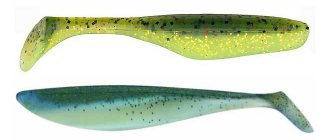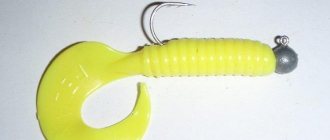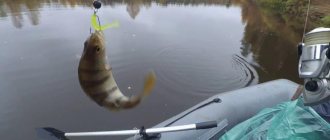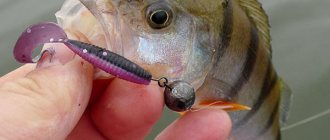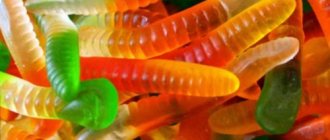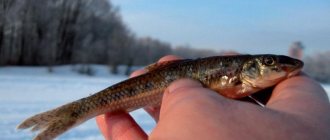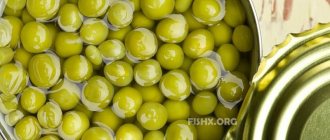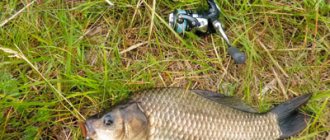Silicone worms are another invention of savvy manufacturers of fishing baits.
This bait “catches” spinners primarily due to its natural behavior in the water, several methods of equipment and special animation that imitates the habits of a live worm during various types of retrieves. However, even in these types of silicone baits, a novice spinning fisher can get confused. To figure out what kind of bait this is, what features are contained in its shape and animation, what equipment methods are used in jig fishing, what types of silicone worms are presented on store shelves, read our review.
Silicone worms - general description of the bait
Silicone worms are a copy of live dung or earthworms, leeches, and larvae.
This type of silicone bait is one of the main baits among spinning anglers in many countries. Initially, a worm made of soft artificial material was produced for catching fish such as largemouth bass or black perch, which live both in North America and in many seas, including the Mediterranean Sea. The use of this bait has shown that many other predatory and other fish respond to it (flatfish, scorpionfish, sea dragon, faridae, etc.).
The body structure of the bait is oblong and round in cross-section. The thickness and length can be different: narrow and short, thick and long, etc. The structure of the body can be either smooth or corrugated, with or without rings. Many lures are equipped with different types of tails. For example, some of the worms have a tail similar to the tail of a twister, the length of which can be equal to the length of the body itself (for example, the Berkley original power worm model).
Some representatives are equipped with a paddle tail (model Mann's jelly worm, zoom speed worm) or a tail in the form of the tip of a billiard cue (for example, roboworm straight worm).
The most interesting thing is that this bait is, as a rule, edible and is also available in various flavors.
Manufacturers, deciding to outwit the fish, created two varieties of worms, some of which are active and others passive baits.
It's quite easy to distinguish them:
- active worms, which display their abilities when the coil moves evenly, have an elongated body and a tail like a twister;
- passive baits are deprived of a tailed assistant, have a resemblance to living invertebrates and show their skill exclusively with jerking retrieves.
![]()
Classification of silicone baits
Body Shape
Twisters
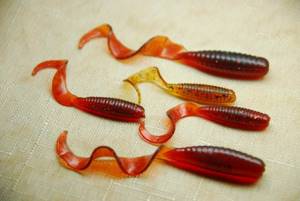
Twisters are perhaps the most popular silicone baits. A typical twister has a cigar-shaped body and tail. There can be one, two, four tails, and sometimes instead of a tail, a twister can have a bunch of silicone threads. With a twister you can cast quite far, and you can catch any fish with it.
Twisters are used when fishing with a jig spinning rod, a retractable leash and on a drop-shot rig, as well as in some very exotic fishing methods, such as fishing in “toads” with a twister on an offset hook with or without a weight.
Vibrotails
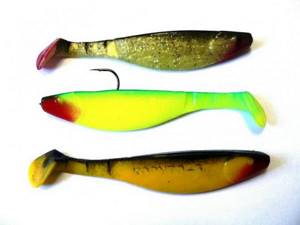
The vibrotail is a silicone bait made in the shape of a fish. The shape of the vibrotail itself can be very different: narrow, wide, laterally flattened, cigar-shaped, etc. The tail can be large or small.
All these characteristics are important under different fishing conditions: in the current it is customary to use vibrating tails with a protruding body and a small tail, and in still water it is better to fish with baits with a wider body and a large tail, which creates powerful vibrations in the water. The vibrotail, like the twister, is widely used, although it is less often used in drop-shot rigs and on a retractable leash.
Silicone worms
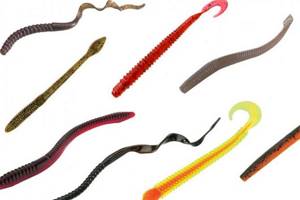
Silicone worms came into fishing use much later than vibrotails and twisters. This was facilitated by the emergence of new mounting methods, as well as the fact that almost all silicone worms are edible and, therefore, can be used in situations where the fish have the opportunity not only to see and feel the bait with the lateral line, but also to taste it. The element of silicone worms is a retractable leash and a drop shot.
Slugs

Slugs are elongated, narrow, elongated baits that do not have any elements that provide active play. Therefore, in order for them to successfully catch fish, they need to be given some kind of movement, that is, animate. They are also used when fishing with a lead or drop-shot, although in the current they can be quite successfully used, mounted on a “eared” weight with a stepped retrieve.
Creatures

Creatures are silicone baits depicting any lizards, squids, insects or their larvae. Creatures appeared on the fishing market relatively recently, so they are only available in an edible version and their purpose is the same as that of slugs and silicone worms, i.e., catching low-active fish with slow retrieval.
Drop shot fish
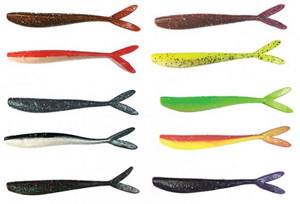
For fishing with drop-shot equipment, special baits are produced that have the shape of a fish and a fork-shaped tail. It is believed that they attract predators better than other baits, using a very slow retrieve with pauses and the bait playing in one place, which, in fact, is the meaning of this equipment. However, some anglers very successfully use them in combination with the “Cheburashka” when jig fishing.
Octopuses
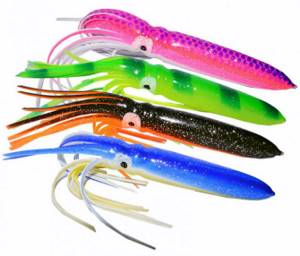
Specialized baits that can be used in a variety of situations, provided they are installed correctly. If you mount an octopus with a treble hook, install a spinner blade in front of it, and then attach it all to an “eared” weight, you will get a catchy jig bait. By placing the octopus on the tee with the tentacles forward, you can catch pike in the grass windows.
Silicone frogs
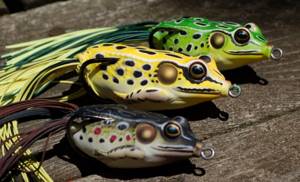
Silicone frogs are designed for catching pike in toad traps. The silicone frog is 100% hook-free and pikes attack it very often, but, unfortunately, the percentage of bites realized when fishing with this bait is quite low.
In addition to the types of silicone baits listed above, wobblers and vibes (rattlins) made from very dense silicone are also currently produced.
Silicone bait size
In fishing stores you can find silicone baits ranging in size from an inch to giant 10-inch ones. Each size has its own application.
Microjig
This type of fishing has many fans. Although the size of the prey during such fishing cannot cause admiration, elegant light tackle allows the spinner to experience emotions when fishing for a small bass, comparable to those experienced by an angler when fishing for a large pike with heavy class tackle. But sometimes you come across trophies.
In microjig, silicone baits measuring 1-1.5 inches are most often used. They are mounted on a jig head or hook with a Cheburashka. The weight of weights when fishing with a microjig can sometimes be less than 1 gram.
Shore fishing
To catch medium to large fish from the shore, 3-4 inch lures are typically used. Lures of this size, especially those mounted on a “eared” weight, can be cast quite far, while problems may arise with larger baits. From the shore you can fish with a jig spinning rod, a retractable leash and a drop shot - the type of bait is selected in accordance with the fishing method.
Trolling
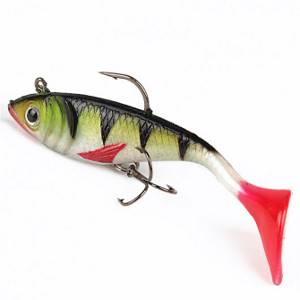
When trolling, silicone baits are rarely used - they still cannot compete with wobblers. If you still need to fish by trolling with silicone, it is better to use lures made in the shape of rattlin. At low speed, this bait will have a very decent game, and a predator may well be tempted by such a gift.
You can fish with silicone in another way, but then you have to sit down with the oars. Fans of “track” fishing fish with silicone in the following way: make a couple of strokes, then stop and continue in the same spirit. It turns out to be something like stepped wiring. It is optimal to use a simple jig head. The size of the bait for pike perch is 50-70 mm, for pike - 70-90 mm.
Characteristics of the bait
2.1 Size of silicone worms
Like any bait, artificial worms can be small in size (2-3 cm), large from 4 cm or more. The size of the bait depends on the size of the future prey and equipment options, fishing methods (heavy jig, microjig). For example, with small worms you can catch perch and many peaceful inhabitants of reservoirs who are not averse to feasting on their living counterparts (for example, dung worms).
It is worth knowing that silicone worms are made from especially soft materials, so any bait can easily stretch to the size you need if there is no suitable one at the moment.
You can learn how to do this using vibrating tails as an example here
2.2 Color of silicone worms
The bait market is rich in a variety of colors, but the most successful colors of silicone worms are considered dark: black, purple, brown or red. Light shades also have a place, everything is learned through experiments.
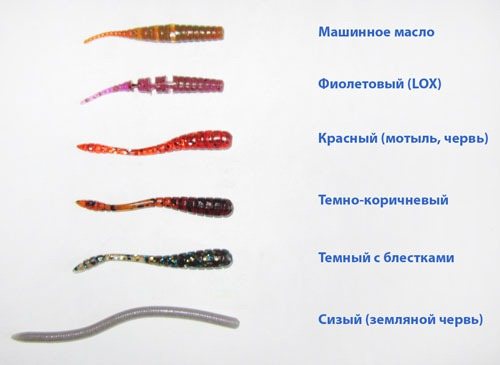
For example, in cloudy or dark water it is better to choose bright colors, and for clear water use natural (close to natural) colors.
How to properly attach a silicone worm
Each type of silicone worm-like bait needs its own method of attachment. Let's look at the most suitable rig options for a soft worm.
Mostly, spinning anglers use offset hooks for non-snaking installation.
Read about what an offset hook is and what advantages it has here.
Also, the most common and simplest method of attachment is a jig head. This installation allows you to successfully fish not only bottom areas, but also middle and surface waters. For surface fishing options, jig heads with a low weight characteristic are used, however, the disadvantage of this option is the possibility of a large number of hooks if fishing occurs in hard-to-reach places in the water basin. Therefore, the option with a jig head is best used in open waters (reservoirs, deep-sea pools, rivers).
Read more about what jig heads are, what types and shapes there are, here
What shapes of worms should I use with a jig head? As a rule, silicone worms with an annular body and a well-developed tail are selected for equipment.
The main thing is to equip the worm correctly, otherwise “crooked” installation will affect its behavior in the water, as it will look unnatural.
A selection of the most suitable models for mounting on a jig head:
- renegade twin tail worm;
- mann's hardNose worm;
- yum ribbontail;
- zoom shakey tail.
Texas or Texas rig
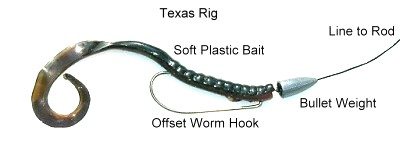
Carolina or carolina rig
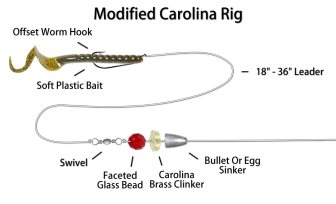
Drop shot or drop shot rig

Installation of a wacky rig , which will be discussed below.
3.1 Features of wacky installation
For this equipment, you should use special baits that do not have any tail options, but only regular rounded tips.
The hook is placed in the middle part of the silicone worm's body. The essence of this installation is that the play of the silicone worm depends on the play (movements) of its limbs, which is achieved by the vibrations of the spinning rod.
Like this, as shown in this video clip from Lucky John
K. Kuzmin will tell you more about the features of installation and wiring
Kosadaka silicone worms
Kosadaka silicone worms
Worms...A large group of invertebrates that play an important role in many food chains. Flat, round, ringed. Some of them are common food items for marine and freshwater fish. That is why manufacturers of silicone baits for catching predators do not deprive the “worm” category of their attention. Relatively recently, in the Kosadaka catalog, I saw 3 new types of worms - Trail Worm, S-Liner Worm and T-Liner Worm.
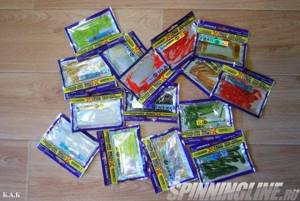
Previously, the company was already engaged in the production of similar baits; its assortment already included such samples as Sly Worm, Sota Worm and Soft Worm. The debut was quite successful, so I immediately fell for the new worms.
Description, appearance
Kosadaka Trail Worm . This slug has a striking resemblance to the very famous Imakatsu Javastick, but this bait cannot be called an exact copy, because There are also many differences from the “ancestor”.
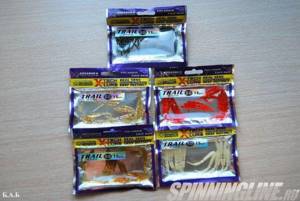
The thickened head part of the body has a triangular shape; as it turned out later, this is not just a fantasy of the manufacturer, but an element of practical importance. There are 2 more thickenings - a small cylindrical one in the central part and a segmented one in the tail. The length of the slug is 5 cm, which immediately makes it suitable for “sport” fishing - catching perch of various sizes and small pike.
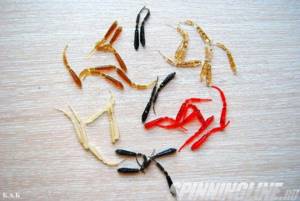
The bait clearly does not have its own game and must be animated by the angler himself. It is unknown what the trail worm imitates; the similarity with a leech is very distant, and I have never seen anything similar in nature. The product is quite strong in tension, but, of course, has weak points in the form of constrictions on the tail. The weight of one worm is 0.36 g. Packaged 15 pieces in a zip bag already familiar to Kosadaka.
Kosadaka S-Liner Worm . A classic worm with a very appetizing (for a fish) appearance. A long elongated segmented body, thickening in the head and narrowing towards the tail, plus an abundance of small legs on the sides and a short thin movable tail.
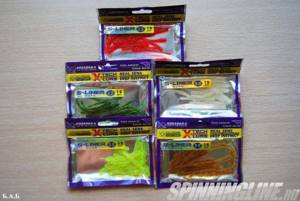
The length of the worm is 5.5 cm, its weight is 0.4 grams. Silicone is quite durable and has almost no weak points, unlike trail worm. The bait almost exactly imitates the Nereis sea worm. And although it is not found in our fresh waters, its appearance still looks very attractive to the fisherman and appetizing to our fish.
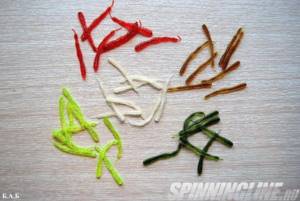
What can we say about the marine life that lives in the coastal rocks, they will definitely like it. There is no game of its own, and the emphasis is not on the game, but on “edibility” and external resemblance to the natural original. Standard packaging, 15 pcs. in a zip bag.
Kosadaka T-Liner Worm . It is difficult to say in whose likeness the manufacturer made this slug, but the underwater creature is difficult to guess - a leech, a worm or a lamprey larva.
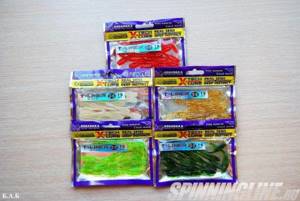
The T-Liner has a long, transversely segmented body; it has three thickenings - in the head, middle and tail parts, each of which is equipped with a pair of small legs.
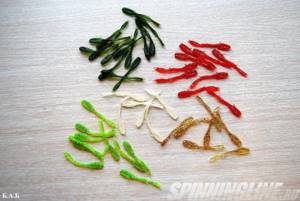
Like the vast majority of baits of this type, this worm does not have its own game. Length 5.5 cm, weight 0.7 grams.
Buoyancy and edibility
A special word should be said about the buoyancy of the described samples. It is positive for all three. Here, as they say, it comes down to taste and color... but personally, I see more advantages in this. Perhaps this is due to the fact that in microjig fishing, floating rubber gives me much more bites than sinking rubber. During the pause after touching the bottom, such a bait takes an almost vertical position, creating a certain convenience for an attack by a predator. This advantage is especially pronounced when fishing on a silty bottom, where the sinking rubber “dives” into the silt, and the floating one remains in the fish’s field of view.
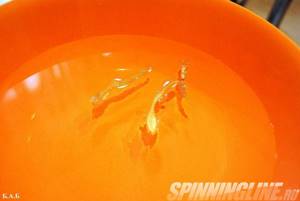
In addition, a silicone bait hanging upside down quite realistically imitates a food object digging in the ground. The last small plus is that floating rubber, due to its lower weight, allows you to use larger hooks or increase the weight of the lead weight to a reasonable extent, and this, in turn, has a positive effect on the casting distance. Rubber is positioned as “edible” due to special impregnation with an attractant, the amount of which is quite plentiful. Silicone leaves a pretty decent greasy stain on a white sheet of paper. The aroma is pronounced, intense, and I would not call it unpleasant.
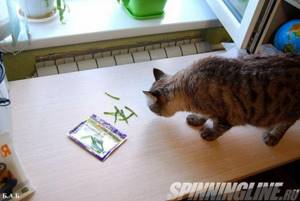
At the same time, it is difficult to identify it, and the manufacturer does not indicate the composition. It seemed to me that the silicone smelled like some kind of fried seafood. A zip bag, of course, is justified; it makes it easier to keep any aroma and impregnation from drying out and eroding.
Color solutions
For all three worms, Kosadaka offers anglers 10 different color options: BG, CS, DS, GR, MO, OD, OT, PL, RS and TG
BG - dark green, with black inclusions.
CS - poisonous yellow with small inclusions of silver and black.
DS - gray-black, with inclusions of blue and golden yellow.
GR - poisonous green with blue-green inclusions.
MO - classic machine oil with black inclusions
OD - cloudy engine oil with small inclusions in the form of red sparkles
OT - light machine oil with black inclusions
PL - white pearlescent opaque
RS - red with black inclusions
TG - straw color (champagne), inclusions in the form of golden sparkles
The choice cannot be called very wide, but for most conditions it is quite enough. There are main favorites - machine oil (MO and OD), there is a very catchy ash shade (DS), but I would be very happy if the color palette was replenished with the working color “Lox” (purple).
Tests on fish
Chub . It always happens to me that I always offer any rubber that claims to be “edible” to this particular fish. And if she “eats” it with pleasure, then other less picky predators are also guaranteed to like it.
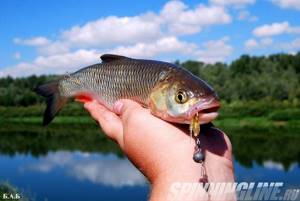
Forehead generally appreciated the new items, especially in the summer heat. It was during the period of its localization on shallow river spits and rifts that catching it with slugs was a real pleasure. Worms also performed well during autumn fishing in small rivers, in already quite cold water, when the chub moved to deeper places and completely ignored wobblers and other active baits.
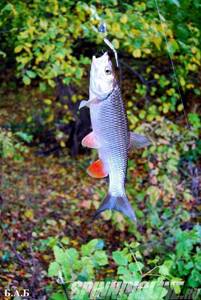
The equipment is traditional - hinged installation of a lead Cheburashka with an offset hook. The most effective summer “presentation” of bait with an active lobe was ridiculously simple - controlled drift along the bottom.
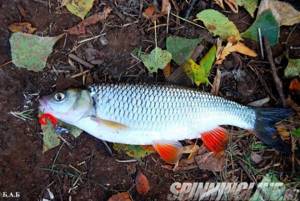
Bites very rarely occurred immediately after splashdown; most occurred during the very phase of “tumbling” of the worm on the ground or at the moment the bait was lifted from the bottom. If the chub was relatively picky, it responded well to a short “step” (half a turn with the reel handle) or low single “explosions”.

Animation that is too sharp or throws that are extremely high will usually result in no bites. Moreover, even when returning to a more delicate presentation, the chub does not show itself in any way; even wobblers cannot stir it up. There is a strong feeling that he is simply getting scared and leaving the fishing zone. Pelagic fishing is also ineffective; in most cases, the fish are limited to sluggish, incredulous pokes, and it never comes to a full bite.
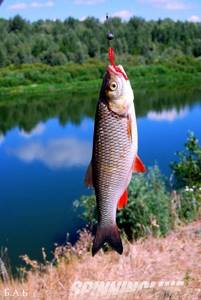
Accordingly, in the current I had to fish with a certain overload, which did not have any negative effect on the number of bites, rather the opposite.
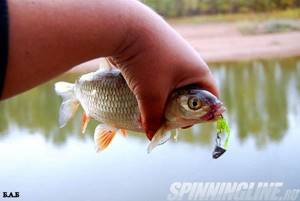
Let me give you an example of one chub fishing. The roll of a medium lowland river, the depth in the fishing zone is about 80 cm, the strength of the current is such that a 3 gram “Cheburashka” reaches the bottom in 4 seconds. We fish together with a friend, he sets 3 grams, but I set as much as 8. His bait hovers above the bottom after turning the reel handle for 2-3 seconds, mine is less than a second.
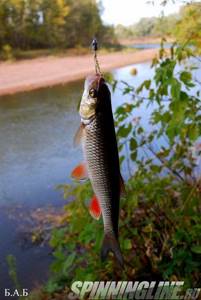
While I do one wiring, he manages to do 2 and start the third. The ratio of effective contacts with fish is 3:1 in my favor. In general, I have long had the impression that when fishing with worms, it is not worth leaving the bottom niche, even in summer.
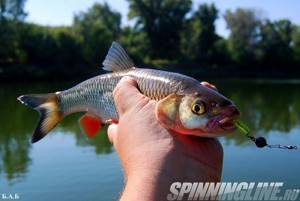
Such a fairly intelligent fish as the chub is accustomed to seeing the food object exactly where it, by definition, exists itself. In our case, strictly at the bottom, but not in the water column (excluding the spring period with muddy water, when the predator relies less on vision).
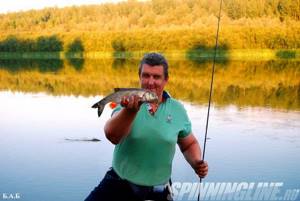
The leader in the number of bites for me was the Trail Worm, and the S and T “liners” received a little less attention.
Sudak . To be honest, I didn’t put much pressure on this fish, because... the size of two inches practically excludes local commercial pike perch, and I still didn’t really want to deliberately cripple the younger generation of fish that is valuable for our region, even with a single hook.
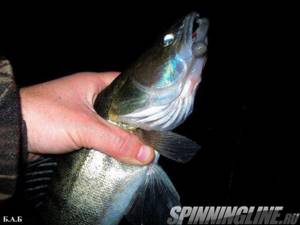
As a result, over several trips I determined the main thing for myself: pike perch are interested in worms, primarily T-liner and S-Liner, and to a lesser extent Trail Worm. The average size of caught fish is 300-500 grams, but the reaction of small pike perch to worms is quite lively, the attacks are passionate. Retrieving is a standard step, but it is advisable to pause longer after touching the bottom; often the zander “pecks” the worm not on its usual fall, but at the moment of dragging the equipment along the ground.
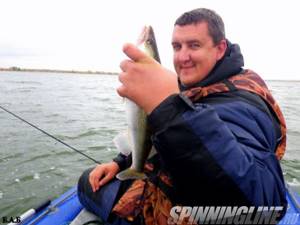
I didn’t notice any particular reaction to perch “explosions” and a series of tosses. During the season, both “machine oils” - the OD and MO colors - worked very well.
Perch . A lot of drive and positive impressions, a lot of bites and landings. This is exactly how the striped one reacts to these worms.

The undisputed favorite is Trail Worm; in terms of the number of contacts with fish, it is at least twice as fast as its competitors.
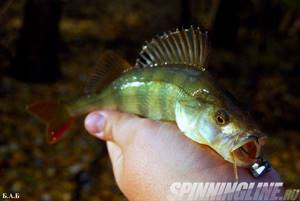
Perch is ready to eat this worm at any time of the day, on any type of fishing and on any equipment. Actually, this predator reacted in approximately the same way to Javastick at one time. The triangular body significantly extends the durability of the bait - one plane (edge) is broken, we move the offset hook to another and continue fishing. Contrary to expectations, the perch does not tear off the tail very often.
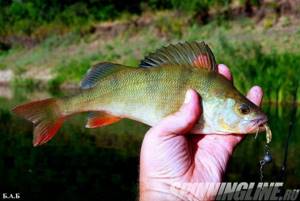
In my opinion, the Trail Worm is not inferior to the same javastick in terms of catchability, so the bait quickly ended up in the box for recognized favorites.

Apparently, there is still something magical in the geometry of this slug for the striped robber. In turn, the S-Liner was remembered for the largest number of bites in clear water.
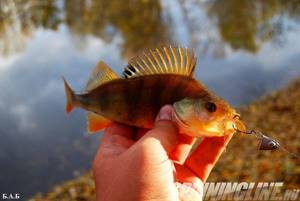
In addition, of all three worms, it is the imitation Nereis that seems edible to the perch; the striped one holds it in its mouth for the longest time and tries to chew it. And, oddly enough, the frequent problem of “dismembering” the bait by perch affects the S-Liner to a greater extent.
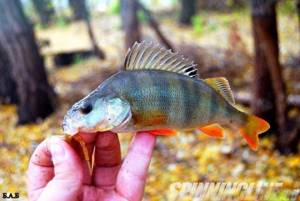
The third slug, T-Liner, stood out for producing above-average stripers most often, especially in ponds and lakes.
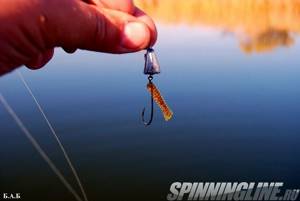
An explanation may be the similarity of the bait to a leech, which is more often found in still water and is part of the food chain of relatively large perch.
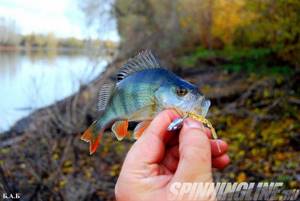
For all three lures that do not have their own game, the basic catching movements are quite universal - the now classic double blast (a short jerk with the brush + a longer stroke), wavy pelagic fishing and dragging along the bottom with pauses.
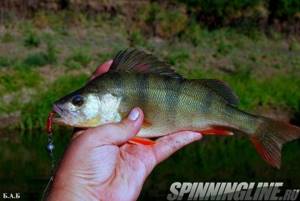
By the way, all three types of worms, due to their positive buoyancy, provide a considerable number of contacts with fish during the pause. Mounting on a hinged “Cheburashka” is preferable to give the bait a greater degree of freedom.
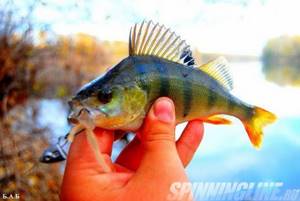
Well, then there is an unplowed field for experiments. Perch is often responsive to unconventional presentation, so experimenting with animation is always useful; the result is not long in coming.
Pike . The success of catching this predator with passive baits always depends on the skill of the fisherman. With twisters and vibrating tails, everything is much simpler - baits that have their own game, with just one movement of the tail, already attract a predator.
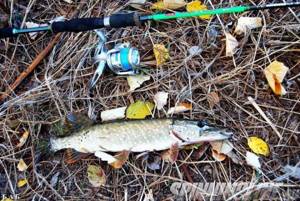
With worms, on the contrary, any movements in the form of a standard step usually do not cause enthusiasm in the toothy one, so you have to work with animation to convince the pike that the object is edible.
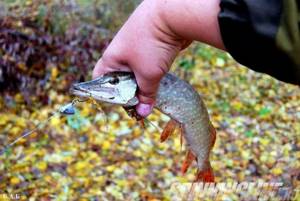
My favorite pike retrieve for this type of bait is casting, touching the bottom, a single high detonation of the bait, then several small tosses with the tip of the spinning rod, at which time the worm makes jerky movements without touching the bottom, another high detonation and a pause. The pike’s nerves usually fail during the first pause, or less often when restarting the retrieve after it.

By the way, the predator often attacks the bait in the first phase of the bait being on the bottom after falling, when the slug is still making residual movements, I see this as another undeniable advantage of floating silicone. Sweeping wave-like pelagic fishing with single touches of the bottom without pauses also brings good results. And in general, it seems to me that pike are more favorable to movements of large amplitude than to short perch jerks, although the latter also have a right to life. At the beginning of summer, the worms were modestly silent, and with the appearance of vegetation they began to bring the first trophies. Until late autumn, I was content with small pike, weighing a maximum of half a kilogram, and I had already gained confidence that commercial pike could not be seduced by such small baits, when suddenly in late autumn, in November, before the ice formed, they suddenly “shot out”. On one of the fishing trips, when ice edges had already appeared off the coast, the pike went on a “strike” in the bite. Two small laces for three from morning to lunch evoked sad thoughts about the lack of further prospects for catching pike, and I assembled a light spinning rod in the hope of “covering” at least a perch; worms were used. A couple of minutes of work, a bite and the weight on the hook is far from perch-like...
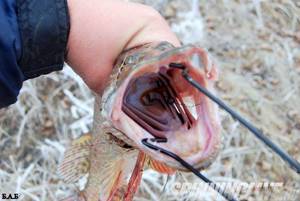
A pike weighing over 2 kg, what a surprise... S-Liner deep in the mouth along with the leash, by some miracle it didn’t cut off. And in the mouth there is a second surprise - an offset hook with a piece of thick braided fishing line, clearly a “piercing” from local fishermen. I continue fishing and within half an hour I get two more of the same beauties.
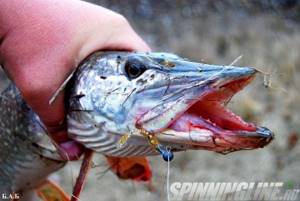
My comrades run over to me in the hope of covering the “party meeting”, but the predator ignores pike-sized baits.
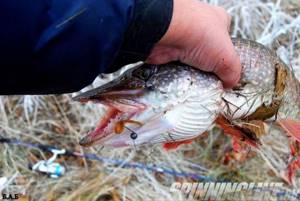
While they are collecting light spinning rods, I manage to catch two more pike of 1.5 kg each and the bite subsides. The next morning - the pike periodically catches small baits, but still outright rejects the more suitable 3-4 inch rubber.
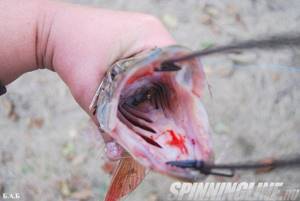
For fun, I fish alternately with large silicone and small ones, during the day and in the evening nothing changes; the commercial pike, although infrequently, effectively attacks the worms and does not seem to notice any bait larger than 2 inches.
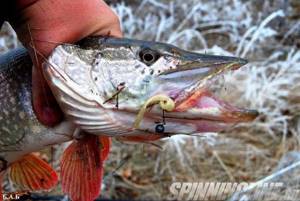
An interesting result to add to the experience of this predator, interesting in all respects. At the end of the season, the clear leader in the number of pike bites was the S-Liner, the toothy T-Liner was a little less attractive, and the top three was closed by the perch and chub favorite Trail Worm.
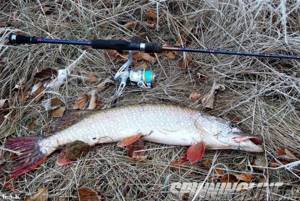
Summing up the season of getting acquainted with new silicone, we can safely say that thanks to Kosadaka, we currently have budget, catchable soft edible baits of excellent quality on the market. Thank you for your attention and happy fishing, colleagues!
Best regards, Andrey Bogatyrev (B.A.B)
Types of postings
Among the most effective types of silicone worm wiring are:
- dragging along the bottom, when the worm moves along the muddy bottom of a reservoir, raising behind it a muddy cloud that so attracts prey;
- step, with short movements and pauses;
- "Wacky" style wiring;
- drop shot technique.
Fishing with weki from K. Kuzmin
The best results of wiring can be observed in the summer season, when the water warms up well and the aroma emanating from the worm spreads throughout the water column. It is better to fish at the edge of algae (grass) or between plantings on free “windows”. However, such conditions do not exclude fishing at other times of the year or on another body of water with steep slopes or edges.
